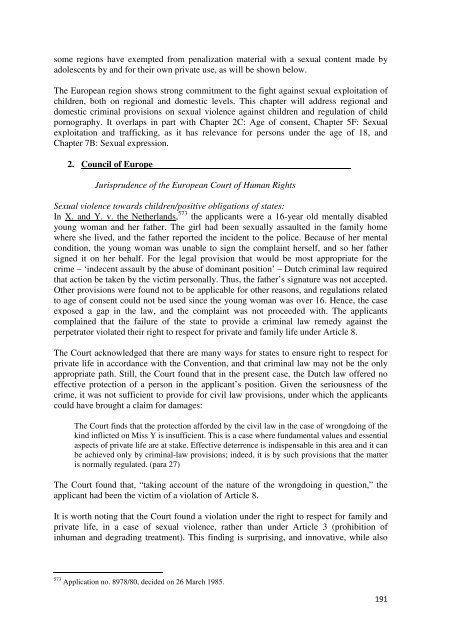Johanna Westeson - The ICHRP
Johanna Westeson - The ICHRP
Johanna Westeson - The ICHRP
Create successful ePaper yourself
Turn your PDF publications into a flip-book with our unique Google optimized e-Paper software.
some regions have exempted from penalization material with a sexual content made by<br />
adolescents by and for their own private use, as will be shown below.<br />
<strong>The</strong> European region shows strong commitment to the fight against sexual exploitation of<br />
children, both on regional and domestic levels. This chapter will address regional and<br />
domestic criminal provisions on sexual violence against children and regulation of child<br />
pornography. It overlaps in part with Chapter 2C: Age of consent, Chapter 5F: Sexual<br />
exploitation and trafficking, as it has relevance for persons under the age of 18, and<br />
Chapter 7B: Sexual expression.<br />
2. Council of Europe<br />
Jurisprudence of the European Court of Human Rights<br />
Sexual violence towards children/positive obligations of states:<br />
In X. and Y. v. the Netherlands, 573 the applicants were a 16-year old mentally disabled<br />
young woman and her father. <strong>The</strong> girl had been sexually assaulted in the family home<br />
where she lived, and the father reported the incident to the police. Because of her mental<br />
condition, the young woman was unable to sign the complaint herself, and so her father<br />
signed it on her behalf. For the legal provision that would be most appropriate for the<br />
crime – ‘indecent assault by the abuse of dominant position’ – Dutch criminal law required<br />
that action be taken by the victim personally. Thus, the father’s signature was not accepted.<br />
Other provisions were found not to be applicable for other reasons, and regulations related<br />
to age of consent could not be used since the young woman was over 16. Hence, the case<br />
exposed a gap in the law, and the complaint was not proceeded with. <strong>The</strong> applicants<br />
complained that the failure of the state to provide a criminal law remedy against the<br />
perpetrator violated their right to respect for private and family life under Article 8.<br />
<strong>The</strong> Court acknowledged that there are many ways for states to ensure right to respect for<br />
private life in accordance with the Convention, and that criminal law may not be the only<br />
appropriate path. Still, the Court found that in the present case, the Dutch law offered no<br />
effective protection of a person in the applicant’s position. Given the seriousness of the<br />
crime, it was not sufficient to provide for civil law provisions, under which the applicants<br />
could have brought a claim for damages:<br />
<strong>The</strong> Court finds that the protection afforded by the civil law in the case of wrongdoing of the<br />
kind inflicted on Miss Y is insufficient. This is a case where fundamental values and essential<br />
aspects of private life are at stake. Effective deterrence is indispensable in this area and it can<br />
be achieved only by criminal-law provisions; indeed, it is by such provisions that the matter<br />
is normally regulated. (para 27)<br />
<strong>The</strong> Court found that, “taking account of the nature of the wrongdoing in question,” the<br />
applicant had been the victim of a violation of Article 8.<br />
It is worth noting that the Court found a violation under the right to respect for family and<br />
private life, in a case of sexual violence, rather than under Article 3 (prohibition of<br />
inhuman and degrading treatment). This finding is surprising, and innovative, while also<br />
573 Application no. 8978/80, decided on 26 March 1985.<br />
191
















